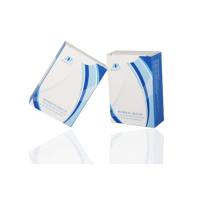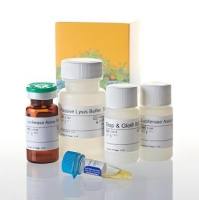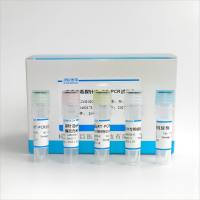Access RT-PCR System (Promega)
丁香园论坛
Access RT-PCR System (Promega)
Description
Promega’s Access RT-PCR System (a) is designed for the reverse transcription (RT) and polymerase chain reaction (PCR) amplification of a specific target RNA from either total RNA or mRNA (1). This one-tube, two-enzyme system provides sensitive, quick, and reproducible analysis of even rare RNAs.
RT-PCR reaction components
RT-PCR Master Mix
reaction vol. (uL)
Water
5
AMV 5X buffer
5
dNTP’s
0.5
25 mM MgSO4
1
Tf1 DNA polymerase
0.5
AMV-RT
0.5
Master Mix 12.5
per reaction
upstream primer (50 pmol)
2.5
downstream primer (50 pmol)
2.5
RNA (0.5-1 ug)
final volume
25
Additional water
1. Determine the amount of RNA that you will add to deliver 0.5 ug, and enter the value in the table.
Sample name: _____________________
OD 260: _____________________; OD 280: _____________________________
260/280: _______________________
Calculate mg/mL of RNA in your samples:
(OD 260 X dilution factor X 40)/1000 OR OD 260 X 2 = ___________________ ug/uL
mL to deliver 0.1 mg RNA __________________________
2. Determine the amount of water needed for your reactions, and enter it in the table. The final volume should equal 25 mL.
3. After calculations, all reactants need to be added. Add the reactants in the following order:
Master mix
Upstream primer
Downstream primer
Water
RNA
Remember to change tips after each use with the RNA.
4. Overlay the reaction with one or two drops (20–40µl) of nuclease-free mineral oil to prevent condensation and evaporation.
5. Proceed directly to thermal cycling the reactions for second strand cDNA synthesis and amplification according to the following thermal cycling profile.
First Strand cDNA Synthesis
1 cycle 48°C for 45 minutes reverse transcription
↓
1 cycle 94°C for 2 minutes AMV RT inactivation and
RNA/cDNA/primer denaturation
↓
Second Strand cDNA Synthesis and PCR Amplification
40 cycles 94°C for 30 seconds denaturation
60°C for 1 minute annealing
68°C for 2 minutes extension
↓
1 cycle (optional) 68°C for 7 minutes final extension
↓
1 cycle 4°C soak
Analysis
1. Analyze the PCR products by agarose gel electrophoresis of 5% of the total reaction. The products will be readily visible by UV transillumination of an ethidium bromide stained gel.
Reverse Transcription-PCR Reaction Mixture Components
The reaction mix is prepared by combining and mixing the indicated volumes of Nuclease-Free Water, AMV/ Tfl5X Reaction Buffer, dNTP Mix, specific upstream and downstream primers, and 25mM MgSO4 in a thin-walled 0.5ml reaction tube on ice. AMV Reverse Transcriptase and TflDNA Polymerase are then added to the reaction. The tube should be vortexed for 10 seconds to mix the components. The reaction is initiated by adding the template. Individual pipet tips were used for all additions, being careful not to cross-contaminate the samples.
A. RNA Template
Successful reverse transcription is dependent on the integrity and purity of the mRNA used as the template. Use procedures for creating and maintaining an RNase-free environment, use sterile tubes, pipette tips, gloves and diethyl pyrocarbonate (DEPC)-treated water. When isolating RNA from samples high in ribonuclease activity, use of a ribonuclease inhibitor such as Promega’s Recombinant RNasin ® Ribonuclease Inhibitor. For optimal results using this system, the RNA template, whether a total RNA preparation, an mRNA population or a synthesized RNA transcript, should be DNA-free. The system’s TflDNA Polymerase has no reverse transcriptase activity under the standard reaction conditions (1), but amplification product will be generated out of these reactions if trace amounts of DNA with similar sequences are present in the template preparation.
B. Control Reactions
To facilitate optimization and troubleshooting of the RT-PCR reactions, perform both positive and negative control reactions. For positive control reactions, use the supplied Positive Control RNA with Carrier and the Upstream and the Downstream Control Primers. For a negative control, substitute sterile nuclease-free water for the RNA template in the reaction.
C. Avoiding Contamination of Nucleic Acids
Take great care to minimize the potential for cross-contamination between samples and prevent carryover of nucleic acid (RNA and DNA) from one experiment to the next. Use a separate work area and pipettor for pre- and post-amplification steps. Use positive displacement pipettes or aerosol-resistant tips to reduce cross-contamination during pipetting. Wear gloves and change them often.
D. Magnesium Concentration
Magnesium is required for proper enzyme function of both AMV Reverse Transcriptase and Tfl DNA Polymerase.
E. Temperature
AMV Reverse Transcriptase is active in the AMV/ Tfl5X Reaction Buffer at temperatures between 37°C and 48°C. We recommend that the reverse transcription reaction be performed at 48°C to minimize the effects of RNA secondary structure and to encourage full-length cDNA synthesis. Following the reverse transcription incubation, we recommend a two-minute incubation at 94°C to denature the RNA/cDNA hybrid and inactivate the AMV Reverse Transcriptase. It has been reported that the AMV Reverse Transcriptase enzyme must be inactivated to obtain high yields of amplification product using thermophilic DNA polymerases such as TflDNA Polymerase.
F. Incubation Times and Number of Cycles
Efficient first strand cDNA synthesis can be accomplished in a 20- to 60-minute incubation at 37–48°C. Following the first strand cDNA synthesis, the AMV Reverse Transcriptase is inactivated and the RNA/cDNA hybrid denatured using a 2-minute incubation at 94°C. This step leads directly into the second strand cDNA synthesis and PCR amplification phase of the procedure. Most RNA samples can be detected using 40 cycles of amplification. If the target RNA is rare or if only a small amount of starting material is available, it may be necessary to increase the number of cycles to 45 or 50. During the extension step, allow approximately 1 minute for every 1kb of amplimer (minimum extension time = 1 minute). A final 7-minute extension at 68°C improves the quality of the final product by extending truncated product to full-length.
:)








